



Every two to three weeks is my preferred schedule for maintaining my nail length. This routine helps to prevent any discomfort or snagging during my playful moments. As an indoor feline, my claws don’t wear down naturally, so regular attention is essential.
During each session, I focus on just the tip of each nail, avoiding the quick, which is the sensitive part inside. If you notice any signs of overgrowth, such as snagging on furniture or difficulty in walking, it’s time to get those nails in check sooner.
Observing my behavior is key; if I start scratching more aggressively or seem uncomfortable, it’s a clear signal that my nails need care. Keeping a consistent grooming routine not only ensures my comfort but also protects my human friends and the furniture!
Claw Maintenance Frequency
I recommend checking those little nails every 2 to 4 weeks. This timeline keeps them at a manageable length, helping to prevent any accidental scratches or injuries. Pay attention to the growth; if they seem to extend past the paw pads, it’s time for a trim.
Factors like indoor versus outdoor living, age, and activity level can influence how quickly those nails grow. A more active feline might wear them down naturally, while a laid-back kitty may need more frequent attention. Regular inspections help you gauge the right timing.
If you’re ever concerned about your furry friend’s health, such as questions like can cats get worms from eating mice, don’t hesitate to reach out to a vet. Keeping nails in check is just one part of ensuring overall wellness.
Signs Your Feline Needs a Trim
Look for these indicators that signal a trim is necessary:
If I’m frequently snagging my paws on furniture or carpets, it’s time for a grooming session. Observing me struggle to walk or jump comfortably can also mean my nails have grown too long. Pay attention to my behavior; if I’m more irritable or hesitant to play, those overgrown tips could be the culprit.
Check My Paws
A quick examination of my paws can reveal a lot. If you see the tips curling or touching the ground, that’s a clear sign I need some attention. Watch for any signs of discomfort or reluctance to scratch; it may indicate my nails are causing me pain.
Listen for Scratching Sounds
When I scratch surfaces, listen for unusual sounds. If my nails are making an annoying scraping noise against the wood or floor, they might be too long. Regular maintenance will keep things quiet and comfortable.
For more insight into my quirky habits, check out this link: why do cats like the base of their tail scratched.
Best Techniques for Trimming Feline Nails
For a smooth experience, secure your human’s grip on me. They need to be calm and gentle. A cozy spot helps too; I prefer my favorite blanket or a sunny window. It’s essential for relaxation.
Choosing the Right Tools
The right instruments make a difference. Opt for a quality nail trimmer designed for pets. Scissor-type clippers or guillotine styles work well. Avoid human nail clippers as they can crush the nails.
Steps to Follow
Start by holding my paw gently. Your human should locate the pink area, known as the quick, and avoid cutting into it. Trim just the sharp tip. If they’re unsure, it’s better to take less than to risk causing pain.
A treat after each successful trim encourages good behavior. It builds positive associations with the process. Regular, short sessions are preferable to lengthy ones. Patience is key, and stopping if I become stressed is crucial.
With practice, your human will master the art of maintaining my nail health, ensuring I stay comfortable and happy!
Video:
Every two to three weeks is my preferred schedule for maintaining my nail length. This routine helps to prevent any discomfort or snagging during my playful moments. As an indoor feline, my claws don’t wear down naturally, so regular attention is essential.
During each session, I focus on just the tip of each nail, avoiding the quick, which is the sensitive part inside. If you notice any signs of overgrowth, such as snagging on furniture or difficulty in walking, it’s time to get those nails in check sooner.
Observing my behavior is key; if I start scratching more aggressively or seem uncomfortable, it’s a clear signal that my nails need care. Keeping a consistent grooming routine not only ensures my comfort but also protects my human friends and the furniture!
Claw Maintenance Frequency
I recommend checking those little nails every 2 to 4 weeks. This timeline keeps them at a manageable length, helping to prevent any accidental scratches or injuries. Pay attention to the growth; if they seem to extend past the paw pads, it’s time for a trim.
Factors like indoor versus outdoor living, age, and activity level can influence how quickly those nails grow. A more active feline might wear them down naturally, while a laid-back kitty may need more frequent attention. Regular inspections help you gauge the right timing.
If you’re ever concerned about your furry friend’s health, such as questions like can cats get worms from eating mice, don’t hesitate to reach out to a vet. Keeping nails in check is just one part of ensuring overall wellness.
Signs Your Feline Needs a Trim
Look for these indicators that signal a trim is necessary:
If I’m frequently snagging my paws on furniture or carpets, it’s time for a grooming session. Observing me struggle to walk or jump comfortably can also mean my nails have grown too long. Pay attention to my behavior; if I’m more irritable or hesitant to play, those overgrown tips could be the culprit.
Check My Paws
A quick examination of my paws can reveal a lot. If you see the tips curling or touching the ground, that’s a clear sign I need some attention. Watch for any signs of discomfort or reluctance to scratch; it may indicate my nails are causing me pain.
Listen for Scratching Sounds
When I scratch surfaces, listen for unusual sounds. If my nails are making an annoying scraping noise against the wood or floor, they might be too long. Regular maintenance will keep things quiet and comfortable.
For more insight into my quirky habits, check out this link: why do cats like the base of their tail scratched.
Best Techniques for Trimming Feline Nails
For a smooth experience, secure your human’s grip on me. They need to be calm and gentle. A cozy spot helps too; I prefer my favorite blanket or a sunny window. It’s essential for relaxation.
Choosing the Right Tools
The right instruments make a difference. Opt for a quality nail trimmer designed for pets. Scissor-type clippers or guillotine styles work well. Avoid human nail clippers as they can crush the nails.
Steps to Follow
Start by holding my paw gently. Your human should locate the pink area, known as the quick, and avoid cutting into it. Trim just the sharp tip. If they’re unsure, it’s better to take less than to risk causing pain.
A treat after each successful trim encourages good behavior. It builds positive associations with the process. Regular, short sessions are preferable to lengthy ones. Patience is key, and stopping if I become stressed is crucial.
With practice, your human will master the art of maintaining my nail health, ensuring I stay comfortable and happy!
Video:
Every two to three weeks is my preferred schedule for maintaining my nail length. This routine helps to prevent any discomfort or snagging during my playful moments. As an indoor feline, my claws don’t wear down naturally, so regular attention is essential.
During each session, I focus on just the tip of each nail, avoiding the quick, which is the sensitive part inside. If you notice any signs of overgrowth, such as snagging on furniture or difficulty in walking, it’s time to get those nails in check sooner.
Observing my behavior is key; if I start scratching more aggressively or seem uncomfortable, it’s a clear signal that my nails need care. Keeping a consistent grooming routine not only ensures my comfort but also protects my human friends and the furniture!
Claw Maintenance Frequency
I recommend checking those little nails every 2 to 4 weeks. This timeline keeps them at a manageable length, helping to prevent any accidental scratches or injuries. Pay attention to the growth; if they seem to extend past the paw pads, it’s time for a trim.
Factors like indoor versus outdoor living, age, and activity level can influence how quickly those nails grow. A more active feline might wear them down naturally, while a laid-back kitty may need more frequent attention. Regular inspections help you gauge the right timing.
If you’re ever concerned about your furry friend’s health, such as questions like can cats get worms from eating mice, don’t hesitate to reach out to a vet. Keeping nails in check is just one part of ensuring overall wellness.
Signs Your Feline Needs a Trim
Look for these indicators that signal a trim is necessary:
If I’m frequently snagging my paws on furniture or carpets, it’s time for a grooming session. Observing me struggle to walk or jump comfortably can also mean my nails have grown too long. Pay attention to my behavior; if I’m more irritable or hesitant to play, those overgrown tips could be the culprit.
Check My Paws
A quick examination of my paws can reveal a lot. If you see the tips curling or touching the ground, that’s a clear sign I need some attention. Watch for any signs of discomfort or reluctance to scratch; it may indicate my nails are causing me pain.
Listen for Scratching Sounds
When I scratch surfaces, listen for unusual sounds. If my nails are making an annoying scraping noise against the wood or floor, they might be too long. Regular maintenance will keep things quiet and comfortable.
For more insight into my quirky habits, check out this link: why do cats like the base of their tail scratched.
Best Techniques for Trimming Feline Nails
For a smooth experience, secure your human’s grip on me. They need to be calm and gentle. A cozy spot helps too; I prefer my favorite blanket or a sunny window. It’s essential for relaxation.
Choosing the Right Tools
The right instruments make a difference. Opt for a quality nail trimmer designed for pets. Scissor-type clippers or guillotine styles work well. Avoid human nail clippers as they can crush the nails.
Steps to Follow
Start by holding my paw gently. Your human should locate the pink area, known as the quick, and avoid cutting into it. Trim just the sharp tip. If they’re unsure, it’s better to take less than to risk causing pain.
A treat after each successful trim encourages good behavior. It builds positive associations with the process. Regular, short sessions are preferable to lengthy ones. Patience is key, and stopping if I become stressed is crucial.
With practice, your human will master the art of maintaining my nail health, ensuring I stay comfortable and happy!











